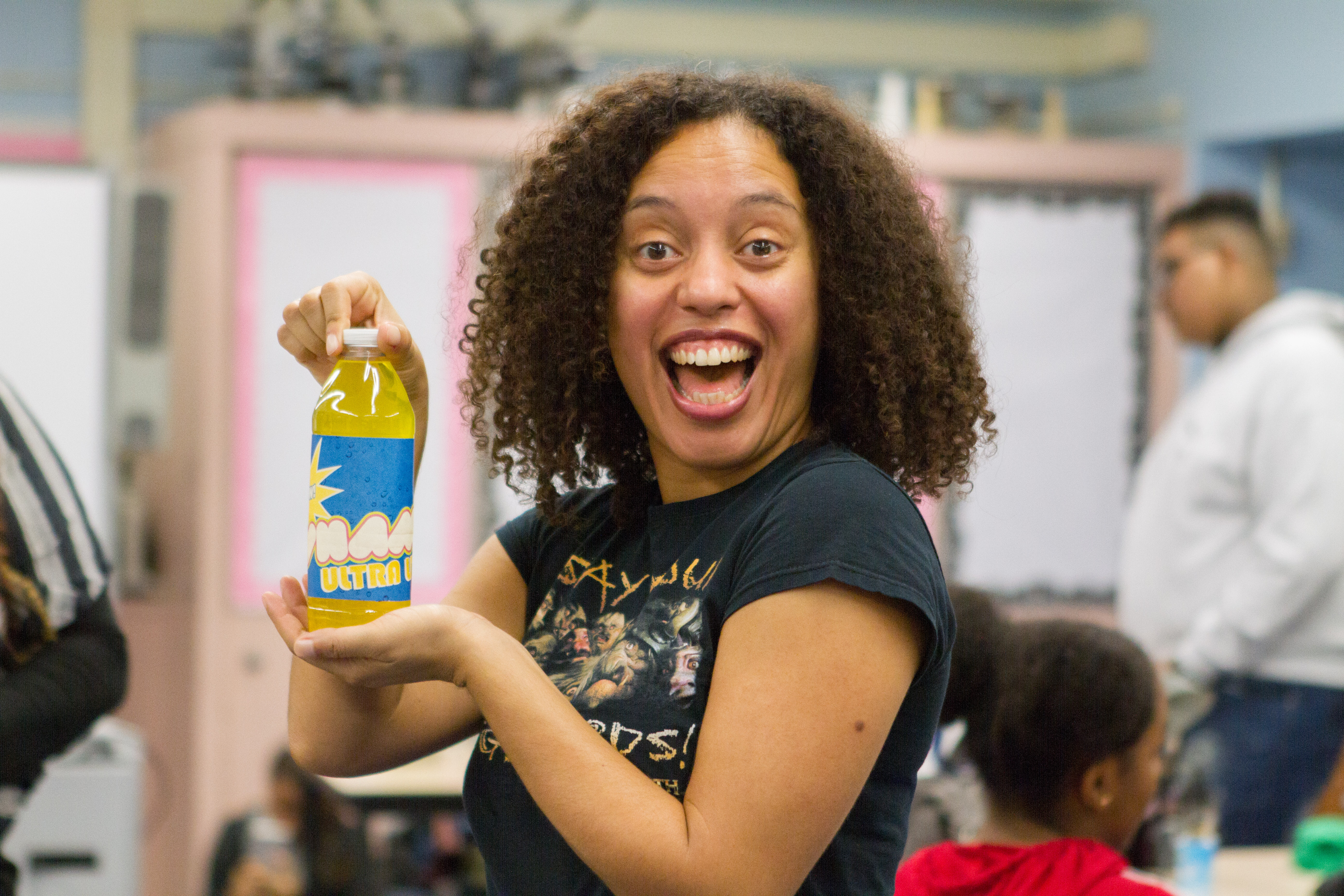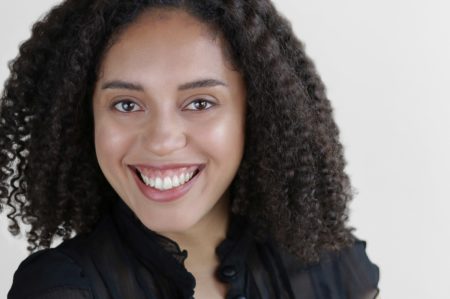Past Resident
Wi-Moto Nyoka

Wi-Moto Nyoka is a writer and performer whose practice is rooted in the exploration of Diasporic identity. She produces horror and sci-fi work for both young adult and adult audiences using interdisciplinary theater and transmedia story worlds. Wi-Moto holds a BFA in Music Theater from the University of the Arts and an MFA for Performance & Interactive Media Arts from Brooklyn College.
“I believe that authorship is powerful because storytellers act as living archives of human history and can build future spaces in the imagination of their communities.”
IG/FB/Twitter: @duskyprojects
 Q&A with Wi-Moto Nyoka (from Crosstown Arts newsletter, December 21, 2021)
Q&A with Wi-Moto Nyoka (from Crosstown Arts newsletter, December 21, 2021)
Crosstown Arts residency alumnus Wi-Moto Nyoka is a writer and trans-media artist. As the founder of Dusky Projects, she creates and produces horror & sci-fi content for young adult and adult audiences. Awards and honors include: Puffin Foundation grant recipient, the Brick’s Comic Book Theater Festival selected librettist, A.R.T/New York Creative Space Grant recipient, MultiStage New Works Contest Semi-Finalist, One-Eyed Rabbit Black Screenwriters Grant Semi-finalist, Other Worlds Film Festival Screenplay Finalist, Austin After Dark Sci-fi Screenplay Finalist, Oregon Scream Week Horror Film Festival Best Dark Sci-fi Screenplay finalist, Oregon Short Film Festival Best Horror Teleplay Award winner, Urban Action Showcase Nominee for Best Action/Adventure Script, Official Latino Short Film Festival Nominee for Out of This World Award, and others.
As an educator, her practice is rooted in culturally responsive pedagogy. Through the use of speculative fiction and creative disciplines such as music, film, and performance, Wi-Moto designs and implements family-friendly curriculum and programming to address literacy, creative problem solving, and the importance of youth advocacy. She is a published author and holds a BFA in Music Theater from the University of the Arts and an MFA for Performance & Interactive Media Arts from Brooklyn College.
Crosstown Arts registrar Jesse Butcher caught up with Wi-Moto to discuss her recent projects, her work as an educator, and her support for diversity in horror and science fiction.
Jesse: I recently viewed your series “The Last Days of Kartika.” The project is an immersive graphic novel/animation/live-action hybrid. What was the writing and execution process like for such an ambitious project?
Wi-Moto: The music came first. I thought of the project like a planetary system where the music was the sun and everything else orbited around that. So, the concept album, Hero How To, was the beginning and tells a story via a musical experience.
From there the web series stemmed, followed up by the graphic musical prequel, and, finally, the performance art opus. All disciplines lead back to the album, and you’ll hear the same songs in every part of the project, remixed and revised, playing in the background, providing transitions, etc.
I used the different disciplines to tell different aspects of the story. The album is really the emotional journey of Dusky Diana, the superhero alter-ego I invented, as she becomes a hero. I’ve always felt that the shortest distance between two points is music, and you can get really metaphorical with your storytelling because of that.
The web series is the nuts and bolts for her recruitment into a rebel faction. If I had the funds, it would have continued into a series where you watch a grassroots rebellion become an enemy of the state. The graphic musical is a prequel that also incorporates motion comics and actually ended with episode one of the web series. This spells out what it takes to be a hero in a five-step plan, hence “Hero How To.” The staged version walks you through her transformation from just regular Diana to Dusky Diana, which you don’t see in the series or hear anything about in the album.
The opus was me experimenting with installation work and scaling the project down to something that could fit in a suitcase. I performed at some comic cons because I just didn’t understand why there weren’t live shows or plays designed for these spaces. I mean, everyone is already in costume, so let’s go nuts! This version was just about exploring the inner life of becoming a hero and how it’s kind of a drag. No one actually wants to fight oppression; they have to. And I wanted to de-romanticize heroism and martyrdom.
Lastly, I integrated motion comics into everything because of the power of comics and their role in establishing archetypes. I wanted these new heroes to be put down in ink to make them larger than life. In the staged version, I don’t even play Diana, and that was, ultimately, the goal — that Dusky Diana become a new hero for everyone. As you mentioned, it was ambitious, and I eventually had to stop working on it, but I hope to be able to revisit it someday.
You developed a prequel to the series that was performed live in theatres titled “Hero How To.” What was the experience of presenting Dusky Diana’s origin story to a live audience? What measures did you take to implement your exact vision?
I kept the production small and reached out to colleagues who had access to rehearsal space. It was only supposed to be a reading with music and projections but the actors took it a step further and staged the draft that I had at the time. They were excited as the only musical at that time that even acknowledged that hip-hop existed was In The Heights. It was also in this funky thing called The Brick’s Comic Book Theater Festival where everyone was kind of playing around with comic book storytelling in the theater, so we were in good company and had support from the festival as well.
Presenting the work was wonderful and terrifying. I had to learn how to operate a lot of tech in real time, and ultimately, it’s what lead to me going to graduate school for interactive media arts. At times, I felt at a complete loss to truly execute my vision, and I decided I didn’t want to ever feel that way again. So, I went out and got some technical skills so I would know what I was doing next time and know better how to communicate it.
All in all, it was a good experience where I learned what my strengths and weaknesses were. Nevertheless, hearing audiences laugh, clap, and react to something I wrote, a story world I made up, made me feel like a sorceress. I felt like I had done actual magic, and I haven’t been able to stop producing work since then.
Your fervid support of diversity in the horror and science fiction genres expands beyond the theater. You have recently received accolades for your work as a screenwriter. When writing for a viewing audience, as opposed to a live audience, did you find yourself adjusting and/or expanding your previous methods and tools?
Absolutely. I read screenplays to see what the pros are doing and experiment. It changed the way I watched films and TV. I started to pay closer attention to the editing, the camera angles, and why the filmmaker might have made the choices they did based on the feelings conveyed in the script. I think that staged plays are love letters to actors, and screenplays are love letters to directors. This is typically what I keep in mind when I’m writing, though things are starting to bleed together. There’s wiggle room in both camps, but at the end of the day, people just want a good story.
As the founder of Dusky Projects, you produce a variety of horror and sci-fi content. One project you host is the “Black Women Are Scary” podcast, dedicated to celebrating and promoting BIPOC authors. Did you find your background in theater helpful in navigating the podcast world as a host and sometimes performer? What is the curatorial process like for determining the works you feature on the podcast?
I find my theater background is essential in everything I do. I think more folks should take theater even if they don’t plan on doing anything in the performing arts. From public speaking to collaborative strategies to creative problem solving, all of these skills you learn in theater. I’m still streamlining the curatorial process, but as of now, I have developed relationships with independent publishers and am able to find and reach out to authors from there. I also have a little story committee made up of our regular donors (It’s a perk they get) who read stories and give their two cents. I didn’t want the podcast to just be what I liked, so I make sure to have other thinkers looking at the work, and I trust their recommendations. I’m also keen on getting as many subgenres as possible to really spotlight the full spectrum of the horror genre.
You also work extensively as an educator with an emphasis on youth advocacy, particularly surrounding literacy. You recently created a monthly free library series and teen night program during your time at Little Island in New York. How does your role as an educator inform your creative practice?
For quite some time, I did what I taught, and I taught what I did, which helps a person build a deep understanding of their practice because they have to break it down and explain to people. I work primarily with young artists which means you have to be very clear and be ready for the most honest feedback you will ever receive in your life. Teaching sharpens your creative problem solving, improvisation, and editing skills, because when an idea doesn’t work in a classroom, it really doesn’t work, and you just have to let it go with no fanfare.
Educational programming is basically producing, and I used those skills when creating and implementing the family programming at Little Island. It was a puzzle that needed solving, right? How to engage tourists and locals, make it a park for all, have arts education be centered but also have it fall in line with health and safety guidelines. Yikes! But most productions, be they theater, film, podcasts, or a hybrid immersive work, are also a puzzle with many moving parts that have to somehow dance together. This is not unlike organizing a field trip with hundreds of children or an end-of-year celebration of their work. You’ve got many moving parts that somehow have to dance together (sometimes literally) and an audience that you need to take care of. The skills that I have gained as an arts educator, I’ve been able to leverage constantly in my arts practice and vice versa.
Wi-Moto, thanks you so much for the in-depth look at the progression of your practice. We can wait to see what the future holds for your work!

